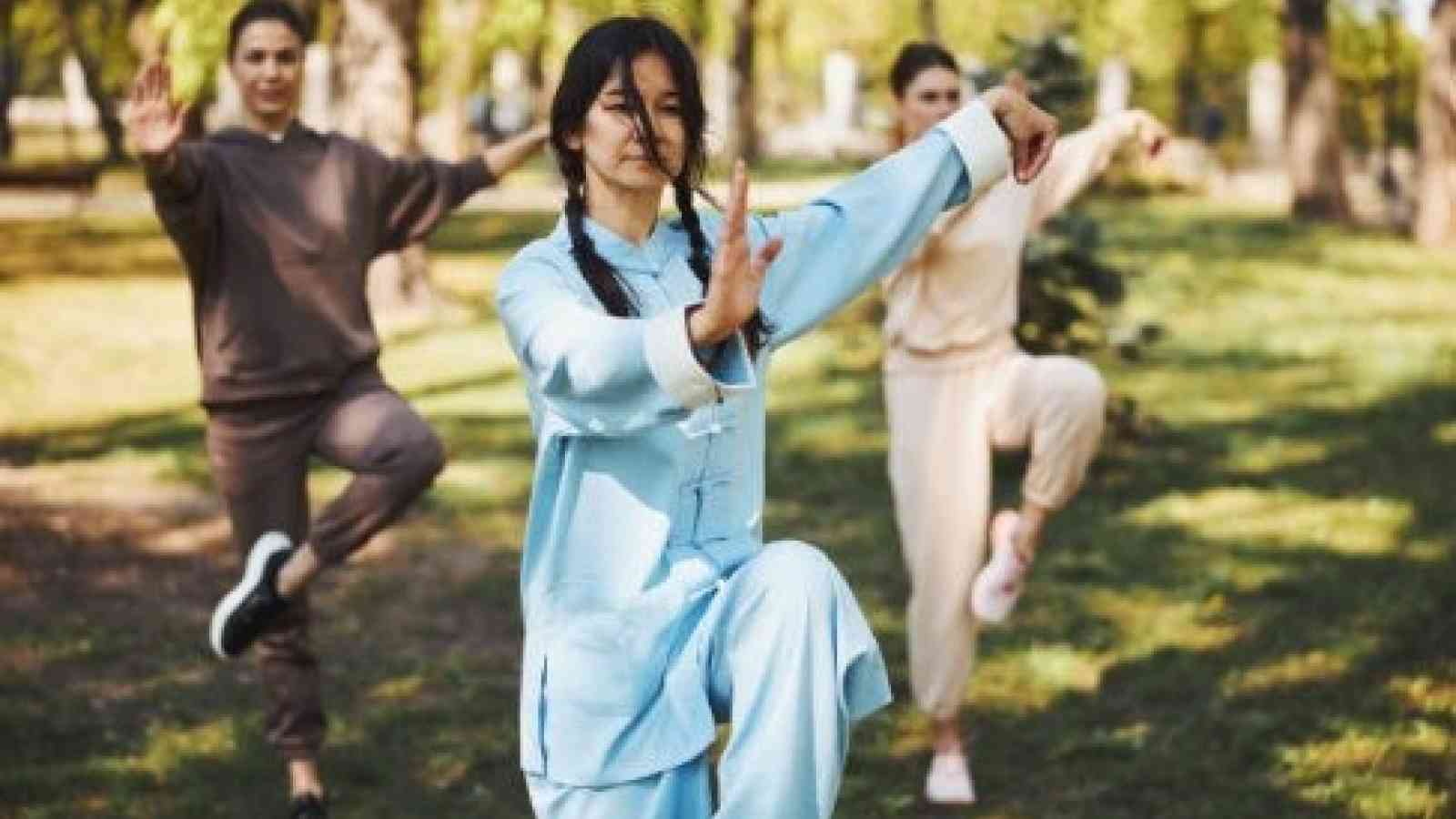
Tai Chi for a Healthier and Happier Life
Tai Chi for a healthier and happier life
By Guoyan Yang, PhD, Western Sydney University
What is Tai Chi?
Tai Chi, also known as Tai Chi Chuan/Quan or Taiji, is a martial art and traditional mind-body exercise that originated in China over 400 years ago. It was developed by a famous martial artist called Chen Wang-Ting at his late years [1]. Since its development, Tai Chi has been practiced as low-to-moderate intensity with repetitive, flowing, meditative movements that aim to cultivate and maintain health and well-being [2]. Tai Chi integrates the essence of Chinese folk and military martial arts, with traditional Chinese medicine theories [1, 3]. The core components of Tai Chi are traditionally described as including sequenced movements, meditative and visualization techniques, and deep, abdominal breathing [1].
There are five major traditional styles of Tai Chi, namely Chen, Yang, Wu, Wu/Hao and Sun styles, and numerous newer styles and extensions. Tai Chi was traditionally only practiced in the Chen family. It wasn’t until Yang Lu-Chan learned Tai Chi from the 14th generation of Chen family and adapted the Chen-style into Yang-style that Tai Chi was taught in Beijing and promoted to other areas of China. It was not until 1928 when Chen Fa-Ke was invited to Beijing to teach Tai Chi that Chen-style Tai Chi was recognized and practiced by a wider population. Today Tai Chi is widely practiced for its health benefits both in Eastern and Western countries. Other classical styles include Wu, Wu/Hao, and Sun styles that are all derived directly or indirectly from Chen style, based on the unique backgrounds of the practitioners and the changes of social environment. For example, Sun-style Tai Chi was developed by Sun Lu-Tang, who learned Chen-style Tai Chi when he was already an expert in other two traditional martial arts (i.e. Xingyi and Bagua). Therefore, we can see the impacts of Xingyi and Bagua in Sun-style Tai Chi movements.
Tai Chi movements consist of a sequence of slow, continuous, graceful movements with circular and spiral body movements, which are known as forms. Each classical style has its own forms. Therefore, the movements and characteristics of different styles vary. For example, within Yang style, there are different forms varying with respect to the number of movements and postures (e.g., 24-, 37-, 72-, 108-, and 150-movement forms), or the overall emphasis (e.g., health maintenance, martial skills, meditation and self-realization, competitive performing arts) [3]. However, because all styles and forms are derived directly or indirectly from Chen style, the core principles and theories of them, such as balance, breathing, coordination, relaxation and concentration are similar.
After the foundation of People’s Republic of China, to improve the overall health of the public, the Chinese government promoted the generalisation of the five classical styles by simplifying these traditional Tai Chi forms and developing several competition forms. In 1956, the General Administration of Sports of China issued a book titled ‘Simplified Tai Chi’ according to the classical Yang-style Tai Chi, which removed difficult and duplicate forms and simplified the 81 forms into 24 forms, which are currently the most popular styles worldwide [1]. In addition, Tai Chi can be practiced with a partner in a more practical manner, which is called ‘pushing hands’ (2-person interactive practice). There are also variations of Tai Chi, which are practiced with weapons, such as a sword, knife, folding fan, or spear.
Regardless of specific style, form, or teaching and practicing approach, Tai Chi itself is inherently a complex intervention, composed of multiple components each of which have potentially independent and synergistic therapeutic value [3]. As a result, it is more appropriate to view Tai Chi as a full-course dinner for practitioners not just a single dish.
What are the health benefits of Tai Chi?
Tai Chi research has been conducted in 31 countries and was found to be beneficial for a wide range of populations, diseases, and outcomes [4]. The top 10 diseases/conditions are hypertension, chronic obstructive pulmonary disease (COPD), diabetes, knee osteoarthritis, heart failure, depression, osteoporosis/ospeopenia, breast cancer, coronary heart disease and insomnia. When performed correctly and regularly, the benefits of Tai Chi may include:
- Decrease stress, anxiety, and depression
- Improve mood, memory, and sleep quality
- Enhance balance, flexibility, and muscle strength
- Improve quality of life
- Enhance the immune system
- Reduce lower back pain
- Help lower blood pressure
- Reduce risk of falls in older adults
“Through the adjustment of mind, body and breathing, Tai Chi provides numerous benefits to both your physical and mental health. Tai Chi can improve balance, strength, and flexibility, enhance heart and brain health, and boost mood. – Dr Guoyan Yang, PhD”
Who can do Tai Chi?
Although in clinical research, most studies focused on the adults and older adults [4], Tai Chi can be practiced by almost everyone. In China, Tai Chi is widely taught in high schools and higher education-related organizations [5]. These is no limitation of gender, age, fitness level, and socioeconomic status to practice Tai Chi. Additional considerations are:
- Numerous physical and mental health benefits
- Meet personal conditions and preferences
- No special requirement of facilities
- Various choices of styles and forms
- Can do Tai Chi in a group or by yourself
- Can do Tai Chi indoors or outdoors
- Enjoy a life-long learning journey
- Gateway to Chinese culture and philosophy
“Because Tai Chi can be easily tailored to personal physical capacity and requirements, it’s accessible to almost everyone who is interested in practicing Tai Chi. Tai Chi could be the perfect activity for the rest of your life. – Dr Guoyan Yang, PhD”
Although Tai Chi is generally safe, for people during pregnancy or with conditions that influence exercise (e.g., joint problems), it is highly recommended to consult their healthcare providers (e.g., GP) and talk to their potential Tai Chi teacher before getting start with Tai Chi. Modification of the practice to meet individualised physical capacity and requirement might be necessary.
How to get started with Tai Chi?
Although, various learning resources such as books and pre-recorded videos are available, the best way to get started with Tai Chi is learning in person from an experienced Tai Chi instructor. An instructor can give you clear instructions, teach you proper techniques, guide you how to avoid common mistakes and gain full benefits from Tai Chi practice. You can get timely feedback on your postures and movements, and you will learn how to practice Tai Chi safely, particularly how to protect your knee joints.
You may learn Tai Chi in a group class or 1:1 class. Regular practice is the key. Usually, peer support is helpful for Tai Chi beginners to develop a good habit.
Alternatively, if you could not find a Tai Chi class in your community, you can try to find a live online Tai Chi class. After COVID-19 pandemic, there are more virtually delivered Tai Chi classes available in many communities.
About the author:
Guoyan Yang, PhD, is a Research Support Program Fellow at NICM Health Research Institute, Western Sydney University, and the Tai Chi instructor at the Next Practice Western Sydney Integrative Medicine Centre.
Reference:
1. Gu L, Shen J: Chen Style Tai Chi. Beijing: People’s Sports Publishing House of China; 2007.
2. Wayne PM, Manor B, Novak V, Costa MD, Hausdorff JM, Goldberger AL, Ahn AC, Yeh GY, Peng CK, Lough M et al: A systems biology approach to studying Tai Chi, physiological complexity and healthy aging: design and rationale of a pragmatic randomized controlled trial. Contemp Clin Trials 2013, 34(1):21-34.
3. Wayne PM, Kaptchuk TJ: Challenges inherent to t'ai chi research: part II-defining the intervention and optimal study design. J Altern Complement Med 2008, 14(2):191-197.
4. Yang G-Y, Sabag A, Hao W-L, Zhang L-N, Jia M-X, Dai N, Zhang H, Ayati Z, Cheng Y-J, Zhang C-H et al: Tai Chi for health and well-being: A bibliometric analysis of published clinical studies between 2010 and 2020. Complementary Therapies in Medicine 2021:102748.
5. Yang JY: A practical exploration on the reform of Taijiquan elective courses in universities based on the Chinese health physical education curriculum model. Journal of Physical Education 2020(06):111-117.

